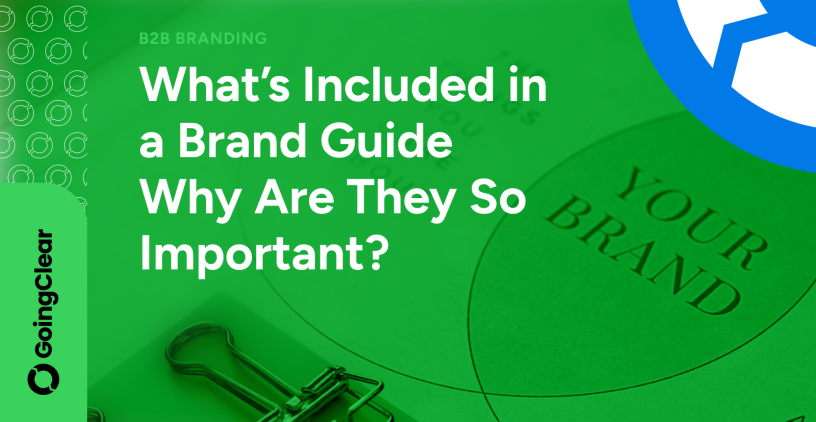Before you can start building a killer B2B brand strategy, you need a strong foundation on which you can lay the bricks of your strategies and ideas. For this, you (and your marketing team) need a clear understanding of your brand’s many unique elements, including a brand guide.
What makes your brand what it is? What are the messages you want to convey to your target audience? Do you know the colors associated with your brand?
All this, and more, is discussed in detail in your brand guide or brand standards. A brand guide can be a few pages long or contain twenty or more pages with all the guidelines that paint a clear picture of your brand.
Why is a brand guide so important? To answer this question, we must first understand just what a brand guide is.
Let’s get into it!
What Exactly Are Brand Guidelines?
A brand guideline is a document (physical or digital) that clearly defines the standards and rules that help accurately represent your brand.
These guidelines can ensure that there is consistency in your marketing efforts. It also shows how your target audience sees your company, what it stands for, and what it does.
At its core, a brand guideline is a rulebook that focuses on the look and feel of your brand. All the messaging and creative assets of your brand, whether it’s on social media or in print advertising, are in your brand guidelines.
What Is the Purpose of Brand Guidelines?
Understanding your brand identity is essential for a successful B2B brand strategy, and that’s what a brand guideline is for. With a well-designed brand guide, your rules are communicated correctly internally, ensuring that your brand will be presented precisely and perfectly.
The incorrect use of colors, your logo, or unusual word usage can damage your brand’s identity and reputation. That’s why brand guidelines must be shared with any staff member who is involved with your brand.
What is in a Brand Guide?
There are many essential elements that must be included in your brand guidelines to ensure absolute accuracy and consistency. You can’t copy another brand’s guidelines because every company is unique.
We’ll discuss all these elements below so they inspire you to create guidelines that will help you make an amazing and effective B2B brand strategy for your company. Use what you learn here to define your brand in as much detail as you can.
Brand Story
You must tell the story of how your brand was founded and explain what your brand wants to achieve and why. This gives your brand more personality and will make marketing efforts easier to personalize. Be detailed in this part of the guidelines so that you can achieve brand consistency, regardless of where your brand is represented.
Target Audiences
It’s essential that you define your brand’s target audience based on interests, demographics, behaviors, and other factors you deem relevant. You should clearly identify your primary and secondary target audiences.
Ensure that your guidelines have detailed customer/buyer personas so that you humanize your customers, which makes marketing more effective.
Brand Logo
Your brand logo is an essential part of your B2B brand strategy because it will represent your brand whenever your audience sees it. That’s why it’s essential to include as much information as possible about your logo in your brand guidelines.
You also need to define the correct ways of using the logo so its design is consistent no matter what form it is in (on merchandise, on your website, on paper, and so on).
Typography
This is an often-neglected element in brand strategies, but fonts matter a lot. Your typography should be easily identifiable and distinct when seen by your audience. Whether it’s in emails, in written communication, or in ad copy, typography must always be consistent.
Choose the font that resonates the most with your brand and always use it; keep in mind that you also need to consider line spacing and related elements.
Color Palette
Your color palette should consist of two or three primary colors associated with your brand. These colors must consistently be used across all your branding. To prevent having various shades of a color within your brand, share the correct RGB, CYMK, and PMS codes in your brand guidelines.
Visual Standards
This part of your brand guide needs to define the visual standards you have clearly. Outline the characteristics that must be present in any images associated with your brand, as well as the visual elements you want to avoid.
Brand Elements
This refers to any secondary visual elements that link to your brand, such as patterns, illustrations, custom icons, and so on. Explain why they are related to your brand and how they are helpful.
Positioning Statement
Your positioning statement clearly defines your target audience. It also focuses on how you want your audience to see your brand. This is an essential element in your brand guidelines and should be as detailed as you can make it.
Key Messages
The key messages of your brand are the taglines and phrases that are used in marketing. This part of your guidelines can also include the general messages you want to communicate to your audience with visuals and copy.
Brand Voice
Your brand voice is very important, and it has to be consistent or your audience will get confused, which can lead to a poor brand image. Base your brand’s voice on your brand’s personality. If it’s serious and stylish, make sure your guidelines emphasize avoiding the use of slang or rude words.
If your brand is playful and whimsical, highlight the kind of funny and cute words you want to use in marketing and communication. You can list all the words you like most for your brand’s personality, as well as the ones you disapprove of.
Brand Statement
Your brand guidelines should also contain your brand statement, which is typically a one-paragraph description of your brand. See it as an opportunity to introduce your brand to someone who has never heard of it before.
Examples
It’s important to include clear and precise examples of every element in your brand guidelines. This will make it easier for anyone working with your brand to avoid making mistakes and keep everything consistent. (By now, you know that consistency is key for a successful B2B brand strategy!)
Talk to GoingClear about your B2B website messaging & brand strategy
We know you want to build a brand strategy that will be successful and reap tremendous rewards for your company. For that, you need a detailed, well-planned brand guide, and GoingClear can help you. Our team of experts in marketing and strategic thinking is ready and able to guide you through this journey. We have years of experience to rely on and can help you find the best approach to your brand guidelines. Call us today to start your brand strategy!

